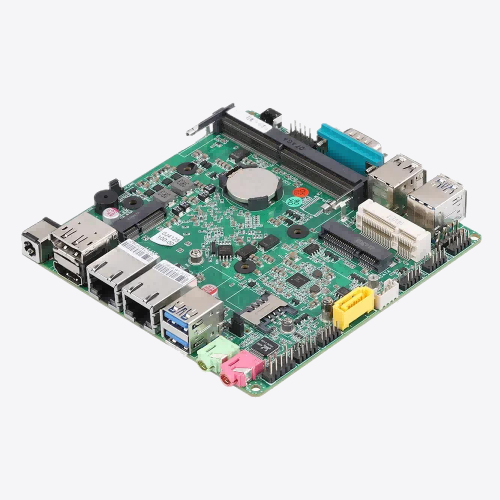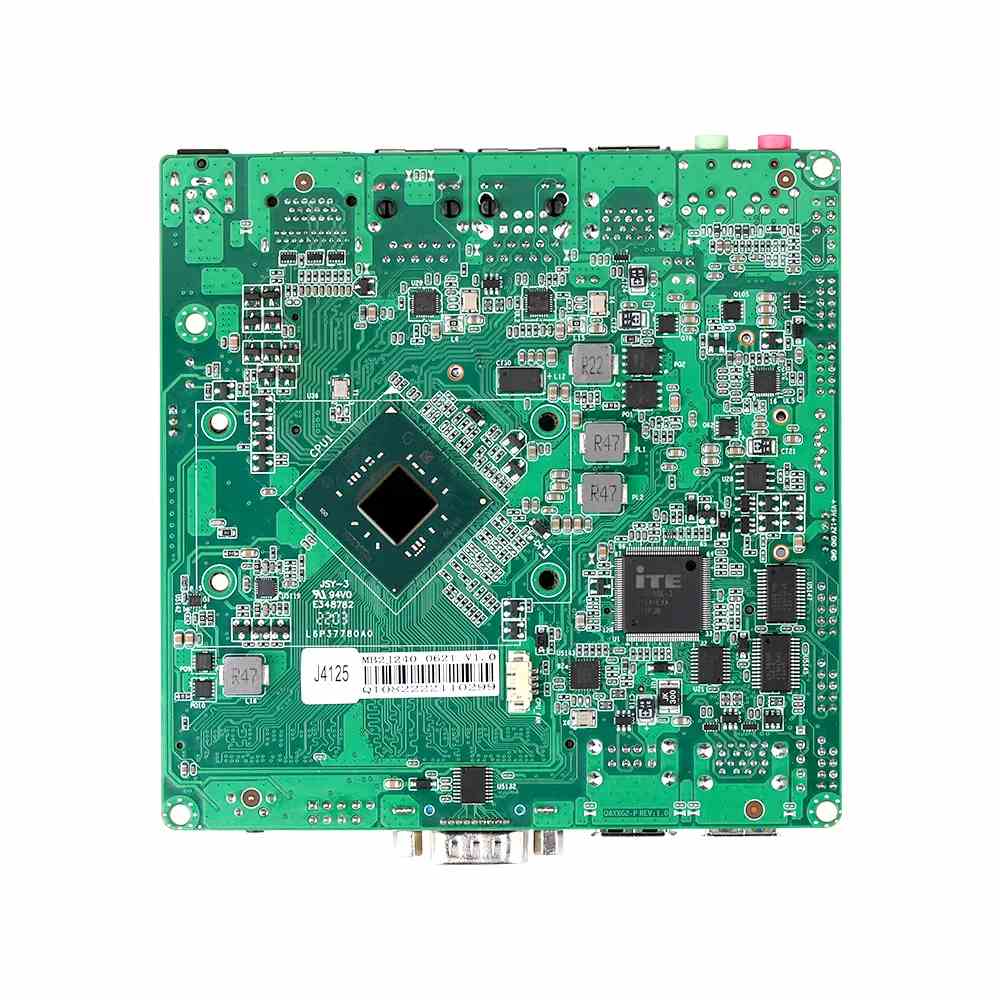Versatile USB Interfaces for High-Density Peripheral Needs

Connect More Devices Without Compromise
Multiple USB ports aren’t just a bonus—they’re a necessity for kiosk systems, POS terminals, and panel-mounted AI nodes. Our Thin Mini-ITX boards support extended USB port configurations while maintaining low-profile mechanics, ensuring seamless integration in compact systems.
| Question | Standard Embedded Board | Multiple USB Ports Board | Exclusive ODM by MiniITXBoard.com |
|---|---|---|---|
| How many USB ports are typically supported? | 2–4 USB ports | Up to 6 USB ports (USB 2.0 + USB 3.0) | Up to 10 ports (selectable headers + rear I/O), customizable mix of USB 2.0, 3.0, and 3.2 Gen 1/2 |
| Can it support high-speed USB peripherals? | Limited to USB 2.0 speeds | Supports USB 3.0 for faster data transfer | USB 3.2 Gen 2 ports (10Gbps) with ESD protection for SSDs, cameras, and high-throughput devices |
| Is USB power delivery stable and isolated? | Shared lines, no power filtering | Individual port fuses and polyfuse protection | Per-port surge protection, 5V/9V PD support (optional), industrial-grade power isolation |
| Can it handle multiple device classes at once? | Bottlenecks under load | Basic multi-device support | Simultaneous keyboard, printer, barcode scanner, and storage device support with stable enumeration |
| Is the USB port layout flexible for my enclosure? | Fixed rear I/O, few options | Front header + rear layout | Custom rear-panel cutouts, right-angle headers, flexible cable routing for constrained installs |
Multiple USB Ports for Versatile I/O Demands
From industrial edge nodes to digital kiosks, our Thin Mini-ITX boards offer expanded USB configurations—supporting peripherals, sensors, and data interfaces with minimal cabling and zero clutter.
High-Density USB Hubs
Best For: Retail terminals, factory touchscreens, USB-driven control panels
Compact boards with up to 10 USB ports—ideal when multiple devices (scanners, cameras, keypads) must connect simultaneously.
When to Choose:
- You need to support multiple peripherals without using external hubs
- Devices require mixed USB 2.0 and 3.2 Gen 1 interfaces
- Space constraints demand integrated I/O on a slim board
Isolated USB Ports with ESD Protection
Best For: Medical kiosks, lab analyzers, public-access charging terminals
Each USB port features power filtering and ESD protection to shield delicate sensors and front-facing ports from spikes or static.
When to Choose:
- Ports face public exposure or harsh power environments
- Connected sensors must avoid data noise or damage
- Application safety and compliance are essential (IEC 60601, etc.)
USB-C + Legacy USB Support
Best For: Modernized thin clients, edge gateways, AI vision nodes
Combines USB-C for high-speed transfer with legacy USB-A ports for traditional peripherals—without bulky add-ons.
When to Choose:
- You require both forward- and backward-compatible I/O
- System must support fast charging or DisplayPort alt mode via USB-C
- You’re migrating from legacy to USB-C devices gradually

Expand I/O Without Expanding Size
Whether you’re building a compact terminal or a kiosk requiring multiple peripherals, USB versatility is non-negotiable. Our Thin Mini-ITX boards offer robust USB connectivity without increasing footprint—supporting legacy peripherals, modern high-speed devices, and secure wired inputs.
- Up to 10 USB Ports: Supports a mix of USB 2.0, 3.2 Gen 1, and front-panel headers—ideal for barcode scanners, card readers, or interactive displays.
- Header Customization Options: Internal pin headers allow flexible routing to chassis front panels, sealed ports, or embedded modules.
- Powered USB Readiness: Optional 12V/24V boosted USB ports available to power peripherals like thermal printers or powered hubs directly—no adapters needed.
Reliable USB Performance for Demanding Applications
To meet the growing demand for stable and high-capacity I/O, miniitxboard provides USB port configurations optimized for performance, power delivery, and flexibility. These USB features are tailored for systems operating in harsh, space-constrained, or always-on environments.
| Feature Category | miniitxboard USB Capabilities |
|---|---|
| Total USB Ports Supported | Up to 10 USB ports (rear I/O + internal headers), including USB 2.0, USB 3.0, and USB 3.2 Gen 1/2 |
| Port Type Options | USB-A and USB-C support, including vertical and right-angle headers |
| High-Speed Support | USB 3.2 Gen 2 (10Gbps) for SSDs, cameras, and other high-bandwidth devices |
| Power Output & Protection | Individual surge and ESD protection, optional 5V/9V/12V powered USB output |
| Flexible Header Integration | Internal headers for custom front-panel routing, sealed boxes, or embedded module connection |
| Multi-Device Handling | Stable support for concurrent input from storage, printers, scanners, cameras, and more |
| Customization Options | USB port mapping, locking connectors, waterproof USB modules, firmware tuning |
| Typical Use Cases | Digital signage, AI vision systems, POS terminals, fanless kiosks, panel PCs |
Thermal & Mechanical Engineering for USB Ports
Multiple USB Ports for Slim, High-Density I/O Deployments
Designed for compact enclosures and modern edge applications, miniitxboard’s USB architecture supports rich I/O without adding bulk. With up to 10 USB ports and support for various types and speeds, these boards simplify integration of multiple peripherals into slim, fanless, or sealed environments.
Supports Up to 10 USB Ports
Ideal for: Multi-peripheral terminals, kiosks, all-in-one systems
Integrated USB options (2.0 / 3.0 / 3.2 Gen 1/2) provide high-density connectivity in compact boards—reducing the need for external hubs.
Mixed USB-C and USB-A Compatibility
Ideal for: Legacy + modern device environments
Boards combine USB-C high-speed transfer and legacy USB-A ports, enabling full backward and forward compatibility in a unified interface.
Power-Isolated USB Lines
Ideal for: EMI-sensitive and powered USB environments
Each USB channel can be protected with power fuses, optional surge filtering, and 5V/9V/12V support to safeguard both the board and connected peripherals.
Integrated Front/Rear Header Layouts
Ideal for: Custom display panels, sealed or angled chassis
Rear I/O and internal headers allow right-angle routing and optimized front-panel integration, even in ultra-slim or space-constrained builds.
Multi-Class Peripheral Handling
Ideal for: Barcode readers, printers, SSDs, touchscreens
Supports simultaneous operation of mixed device types with no bottlenecks—ensuring reliable enumeration and stable data flow.


Smart USB Design for Slim and Powerful Systems
At miniitxboard, we design our USB ports to work better in small, slim devices like kiosks, digital displays, and smart terminals. Our boards don’t just add more ports—they’re built to make every USB port stronger, safer, and easier to use in real-world systems.
Clean Signal for Fast Data
We build our USB circuits to keep signals clear, even with lots of ports close together. That means faster and more stable data transfer for things like barcode scanners, SSDs, and cameras.
USB Ports That Fit Your Case
Our USB ports are placed carefully so they line up with your custom case. We support straight, angled, or hidden USB connectors—making installation quick and neat, even in tight spaces.
Safe Power for All Devices
Each USB port gives steady power for devices like card readers, touchscreens, or printers. Built-in protection keeps your system safe from power spikes or overloads.
Reliable USB Connectivity, Built for Harsh and Slim Environments
At miniitxboard, our USB designs are tested to perform in tough real-world conditions—where space is tight, airflow is limited, and uptime matters. From factory floors to retail kiosks, our boards deliver stable, multi-port USB performance without extra cooling or bulky add-ons.
Smart USB Layout Design
Ports are placed to avoid signal interference and allow clean cable routing. This keeps data stable and helps installers quickly connect scanners, touchscreens, and printers in tight builds.
Power Stability Under Load
Even when many USB devices are connected at once, power delivery stays steady. Each port has overcurrent and surge protection for reliable long-term use in 24/7 systems.
Stress-Tested Under Real Conditions
Our USB ports are tested through heat cycles and power surge simulations. They’re made to work in sealed or fanless enclosures—without overheating or crashing.
Slim-System Friendly
Perfect for panel PCs, vending systems, and under-desk signage—our USB layouts are compact, rear-accessible, and ready for deployment in space-limited environments.
Learn More: How to Get the Most from Multiple USB Ports
Want to know how to design smarter with more USB connectivity? Explore our expert articles below to discover how miniitxboard helps you power more devices in less space—with fewer hassles.
Intel Celeron N150: Balancing Power, Performance, and Practical Efficiency in Compact Systems
Table of Contents 1. Introduction: The Role of the N150 in Modern Embedded Platforms 2. CPU Microarchitecture and Platform Integration 3. Thermal Design and Power Consumption in Real Deployments 4.…
Intel Celeron N300: Engineering Low-Power Performance for Modern Embedded Systems
Table of Contents Introduction: The N300’s Place in Embedded and SFF Markets Architecture & SoC Integration Power Consumption & Idle Realities BIOS & Tuning for Sustained Performance Thermal Performance &…
